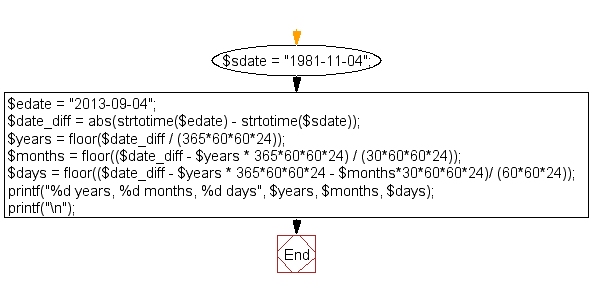PHP Date Exercises : Calculate the difference between two dates (in years, months, days)
PHP date: Exercise-4 with Solution
Write a PHP script to calculate the difference between two dates.
Sample dates : 1981-11-04, 2013-09-04
Sample Solution:
PHP Code:
<?php
$sdate = "1981-11-04";
$edate = "2013-09-04";
$date_diff = abs(strtotime($edate) - strtotime($sdate));
$years = floor($date_diff / (365*60*60*24));
$months = floor(($date_diff - $years * 365*60*60*24) / (30*60*60*24));
$days = floor(($date_diff - $years * 365*60*60*24 - $months*30*60*60*24)/ (60*60*24));
printf("%d years, %d months, %d days", $years, $months, $days);
printf("\n");
?>
Sample Output:
31 years, 10 months, 12 days
Flowchart :

PHP Code Editor:
Have another way to solve this solution? Contribute your code (and comments) through Disqus.
Previous: Write a PHP script to print the current date in the following format. To get current date's information you can use the date() function.
Next: Write a PHP script to convert a date from yyyy-mm-dd to dd-mm-yyyy.
What is the difficulty level of this exercise?
Test your Programming skills with w3resource's quiz.
PHP: Tips of the Day
How to Sort Multi-dimensional Array by Value?
Try a usort, If you are still on PHP 5.2 or earlier, you'll have to define a sorting function first:
Example:
function sortByOrder($a, $b) {
return $a['order'] - $b['order'];
}
usort($myArray, 'sortByOrder');
Starting in PHP 5.3, you can use an anonymous function:
usort($myArray, function($a, $b) {
return $a['order'] - $b['order'];
});
And finally with PHP 7 you can use the spaceship operator:
usort($myArray, function($a, $b) {
return $a['order'] <=> $b['order'];
});
To extend this to multi-dimensional sorting, reference the second/third sorting elements if the first is zero - best explained below. You can also use this for sorting on sub-elements.
usort($myArray, function($a, $b) {
$retval = $a['order'] <=> $b['order'];
if ($retval == 0) {
$retval = $a['suborder'] <=> $b['suborder'];
if ($retval == 0) {
$retval = $a['details']['subsuborder'] <=> $b['details']['subsuborder'];
}
}
return $retval;
});
If you need to retain key associations, use uasort() - see comparison of array sorting functions in the manual
Ref : https://bit.ly/3i77vCC
- New Content published on w3resource:
- HTML-CSS Practical: Exercises, Practice, Solution
- Java Regular Expression: Exercises, Practice, Solution
- Scala Programming Exercises, Practice, Solution
- Python Itertools exercises
- Python Numpy exercises
- Python GeoPy Package exercises
- Python Pandas exercises
- Python nltk exercises
- Python BeautifulSoup exercises
- Form Template
- Composer - PHP Package Manager
- PHPUnit - PHP Testing
- Laravel - PHP Framework
- Angular - JavaScript Framework
- Vue - JavaScript Framework
- Jest - JavaScript Testing Framework
